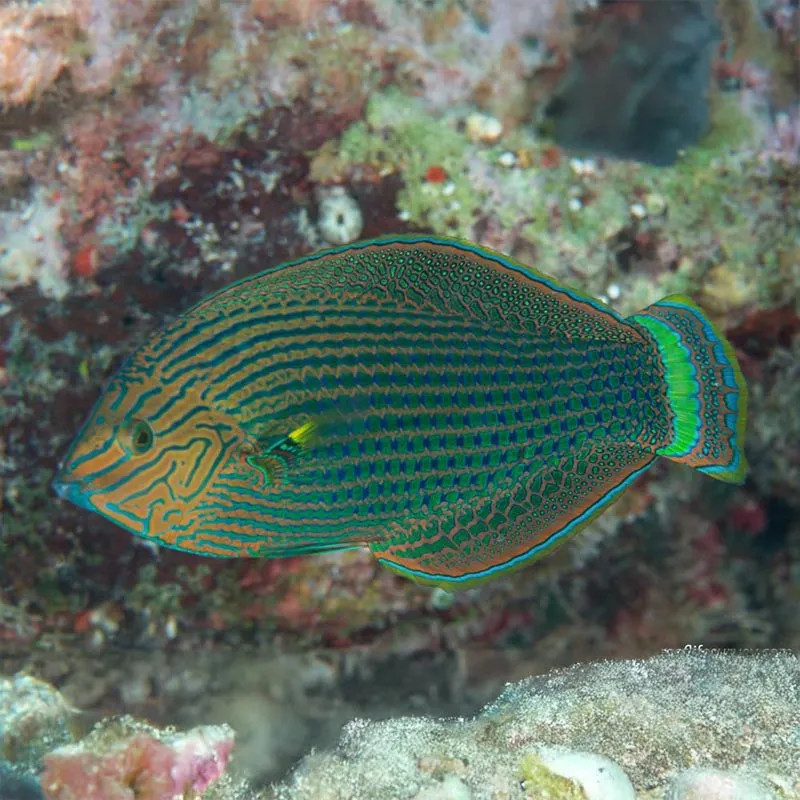Stocks Available
Mystery Wrasse
SKU:226755
Pseudocheilinus ocellatus
1.25-2.25 INCH

Stock Available
Introduction: • Common Name: Dusky Wrasse • Native Habitat: Inhabits the coral reefs and rocky areas of the Indo-Pacific region, particularly around the coasts of the Philippines, Indonesia, and the Great Barrier Reef. Physical Characteristics: • Appearance: The Dusky Wrasse features a streamlined body with a mix of brown, green, and yellow hues. Its coloration can vary, often displaying a gradient effect with darker shades on the back and lighter tones on the belly. • Size: Typically grows to about 6 to 8 inches (15 to 20 cm) in length. • Fins: Characterized by long, flowing dorsal and anal fins that enhance its agile swimming ability. Habitat Requirements: • Tank Size: A minimum tank size of 50 gallons is recommended, providing enough space for swimming and hiding. • Water Conditions: o Temperature: Prefers a temperature range of 72°F to 78°F (22°C to 26°C). o pH Level: Ideal pH range is between 8.1 and 8.4. o Salinity: Maintain salinity between 1.020 and 1.025 for optimal health. • Aquascaping: The tank should have plenty of live rock, caves, and crevices for hiding, as well as open swimming areas. Diet: • Feeding Habits: Carnivorous, primarily feeding on small invertebrates and crustaceans in the wild. • Dietary Options: In captivity, they thrive on a varied diet that includes high-quality pellets, frozen foods like brine shrimp, and live foods such as ghost shrimp or small fish. • Feeding Frequency: Feed them once or twice daily, ensuring all food is consumed to maintain tank cleanliness. Compatibility: • Temperament: Generally peaceful but can be territorial, especially during breeding or when establishing dominance. • Tank Mates: Compatible with a variety of fish species, including other wrasses, tangs, and larger community fish. • Incompatibilities: Avoid keeping with overly aggressive fish or small species that may be seen as prey. Care Level: • Difficulty: Moderate; the Dusky Wrasse requires stable water conditions and a varied diet to thrive, making it suitable for hobbyists with some experience. • Health Monitoring: Regular water changes and monitoring for common issues like parasites or stress-related conditions are essential for maintaining health. Breeding: • Breeding Behavior: Not commonly bred in captivity. In the wild, they exhibit complex behaviors during spawning, often in pairs. • Fry Care: Once eggs hatch, the larvae are planktonic and require a suitable diet of microscopic food until they mature. Economic Considerations: • Market Demand: Popular among aquarium enthusiasts due to their vibrant appearance and active behavior. • Pricing: Typically falls within a moderate price range, influenced by size and availability. Sustainability and Conservation: • Wild Population: Generally stable, although habitat loss and overfishing can impact local populations. • Aquaculture: Some efforts are being made to breed wrasses in captivity, which helps reduce pressure on wild populations. Conclusion: The Dusky Wrasse is a beautiful and lively species that adds color and activity to marine aquariums. With proper care, including stable water conditions and a varied diet, they can thrive, making them a favorite choice among marine fish enthusiasts.
Data sheet
16 other products in the same category:
Customers who bought this product also bought: